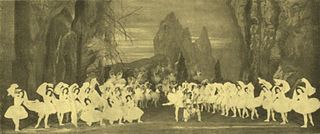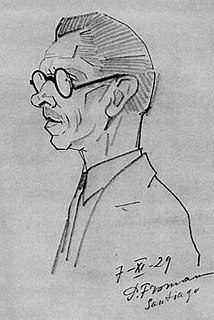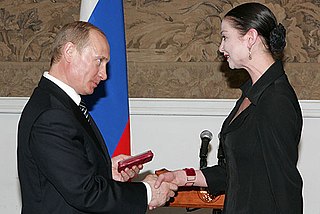
Rudolf Khametovich Nureyev was a Soviet-born ballet dancer and choreographer. Nureyev is regarded by some as the greatest male ballet dancer of his generation.
The Mariinsky Ballet is the resident classical ballet company of the Mariinsky Theatre in Saint Petersburg, Russia. Founded in the 18th century and originally known as the Imperial Russian Ballet, the Mariinsky Ballet is one of the world's leading ballet companies. Internationally, the Mariinsky Ballet continues to be known by its former Soviet name the Kirov Ballet. The Mariinsky Ballet is the parent company of the Vaganova Ballet Academy, a leading international ballet school.

The Mariinsky Theatre is a historic theatre of opera and ballet in Saint Petersburg, Russia. Opened in 1860, it became the preeminent music theatre of late 19th-century Russia, where many of the stage masterpieces of Tchaikovsky, Mussorgsky, and Rimsky-Korsakov received their premieres. Through most of the Soviet era, it was known as the Kirov Theatre. Today, the Mariinsky Theatre is home to the Mariinsky Ballet, Mariinsky Opera and Mariinsky Orchestra. Since Yuri Temirkanov's retirement in 1988, the conductor Valery Gergiev has served as the theatre's general director.

Romeo and Juliet, Op. 64, is a ballet by Sergei Prokofiev based on William Shakespeare's play Romeo and Juliet. First composed in 1935, it was substantially revised for its Soviet premiere in early 1940. Prokofiev reused music from the ballet in three suites for orchestra and a solo piano work.

Russian ballet is a form of ballet characteristic of or originating from Russia.

Le Corsaire is a ballet typically presented in three acts, with a libretto originally created by Jules-Henri Vernoy de Saint-Georges loosely based on the poem The Corsair by Lord Byron. Originally choreographed by Joseph Mazilier to the music of Adolphe Adam, it was first presented by the ballet of the Théâtre Impérial de l’Opéra in Paris on 23 January 1856. All modern productions of Le Corsaire are derived from the revivals staged by the Ballet Master Marius Petipa for the Imperial Ballet of St. Petersburg throughout the mid to late 19th century.
La Fille mal gardée is a comic ballet presented in two acts, inspired by Pierre-Antoine Baudouin's 1765 painting, La réprimande/Une jeune fille querellée par sa mère. The ballet was originally choreographed by the Ballet Master Jean Dauberval to a pastiche of music based on fifty-five popular French airs. The ballet was premiered on 1 July 1789 at the Grand Théâtre de Bordeaux in Bordeaux, France under the title Le ballet de la paille, ou Il n'est qu'un pas du mal au bien.

Altynai Abduakhimkyzy Asylmuratova is a Kazakh former ballerina who is artistic director of the ballet company at Astana Opera. She is a former prima ballerina with the Kirov Ballet and a guest artist all over the world.

La Bayadère is a ballet, originally staged in four acts and seven tableaux by French choreographer Marius Petipa to the music of Ludwig Minkus. The ballet was staged especially for the benefit performance of the Russian Prima ballerina Ekaterina Vazem, who created the principal role of Nikiya. La Bayadère was first presented by the Imperial Ballet at the Imperial Bolshoi Kamenny Theatre in St. Petersburg, Russia, on 4 February [O.S. 23 January] 1877. From the first performance the ballet was universally hailed by contemporary critics as one of the choreographer Petipa's supreme masterpieces, particularly the scene from the ballet known as The Kingdom of the Shades, which became one of the most celebrated pieces in all of classical ballet. By the turn-of-the 20th century, The Kingdom of the Shades scene was regularly extracted from the full-length work as an independent showpiece, and it has remained so to the present day.

The Sergeyev Collection is a collection of choreographic notation, music, designs for décor and costumes, theatre programs, photos and other materials that document the repertory of the Imperial Ballet of St. Petersburg, Russia at the turn of the 20th century. The majority of the choreographic notations document with varying degrees of detail the original works and revivals of the renowned choreographer Marius Petipa, who served as Premier Maître de ballet of the St. Petersburg Imperial Theatres, as well as notation and music documenting the ballets of Lev Ivanov, who served as second Maître de ballet. Also included in the collection are choreographic notation documenting dances from various operas by both Petipa and Ivanov, respectively.
Paquita is a ballet in two acts and three scenes originally choreographed by Joseph Mazilier to music by Édouard Deldevez and Ludwig Minkus. Paul Foucher received royalties as librettist.
Moscow Ballet has toured the United States and Canada during the holiday season since 1993 and is exclusively represented by Talmi Entertainment Inc for these tours. There are 70 to 80 Russian-trained classical dancers on the annual N.A. tour who fly in from the former republic of Russia. Stanislav Vlasov, a former principal artist of the Bolshoi Ballet, was the first artistic director on the North American tour in 1993. Vlasov's debut in the United States was at Carnegie Hall in 1957.

Vladimir Viktorovich Vasiliev is a Soviet and Russian ballet dancer and choreographer. He was a principal dancer with the Bolshoi Ballet and its director from 1995 to 2000. He was best known for his role of Spartacus and his powerful leaps and turns. He received the People's Artist of the USSR (1973).

The Vaganova Academy of Russian Ballet is a school of classical ballet in St Petersburg, Russia. Established in 1738 during the reign of Empress Anna, the academy was known as the Imperial Ballet School until the Soviet era, when, after a brief hiatus, the school was re-established as the Leningrad State Choreographic Institute. In 1957, the school was renamed in honor of the pedagogue Agrippina Vaganova, who cultivated the method of classical ballet training that has been taught there since the late 1920s. Many of the world's leading ballet schools have adopted elements of the Vaganova method into their own training.

Raymonda is a ballet in three acts, four scenes with an apotheosis, choreographed by Marius Petipa to music by Alexander Glazunov, his Opus 57. It was first presented by the Imperial Ballet at the Imperial Mariinsky Theatre on 19 January [O.S. 7 January] 1898 in Saint Petersburg, Russia. The ballet was created especially for the benefit performance of the Italian ballerina Pierina Legnani, who created the title role. Among the ballet's most celebrated passages is the Pas classique hongrois from the third act, which is often performed independently.
Vasili Ivanovich Vainonen, also spelled Vasily (1901-1964), was a renowned Ingrian Soviet choreographer, mainly for the Kirov Ballet, now known as the Mariinsky Ballet, with which he worked from 1930 to 1938.

Ruslan Vasilyevich Skvortsov is a Russian principal dancer of the Bolshoi Ballet.

Yulia Victorovna Makhalina, also Yulia, is a Russian ballet dancer. Since 1986, she has been with the Kirov/Mariinsky Ballet where she is a principal dancer. Along with Ulyana Lopatkina, Makhalina is a member of 'the basketball team', a group of Kirov dancers who are characterized for being especially tall and slender.

Vladimir Djouloukhadze, or Juluhadze, or Djuluhadze,, born in 1952, Tbilisi, Republic of Georgia, USSR, is a Georgian ballet dancer, a former principal of the Georgian National Opera and Ballet Theater of Tbilisi, Ballet Master, teacher, and choreographer.
Oleg Mikhailovich Vinogradov is a Russian former dancer, choreographer and ballet director. He graduated from the Vaganova Academy of Russian Ballet under Alexander Ivanovich Pushkin and went on to become a choreographer, working with some of the Soviet Union's most important ballet companies, including the Kirov Ballet and the Bolshoi Ballet. In the early 1970s he was artistic director and chief choreographer at the Maly Theatre Ballet, and became artistic director of the Kirov Ballet in 1977. During this period, relations between the Soviet Union and the United States grew warmer, and the Kirov Ballet embarked on several US tours for the first time in decades. Vinogradov became the first Soviet ballet master to invite Maurice Béjart and Roland Petit to stage works for the Kirov, and also helped to bring authorized productions of George Balanchine's ballets to Russia for the first time. He was named a People's Artist of the USSR in 1983.